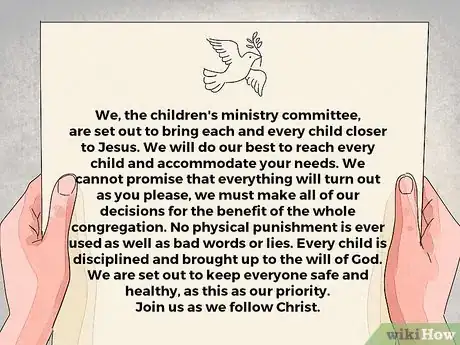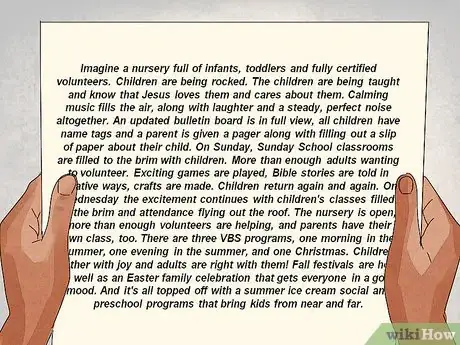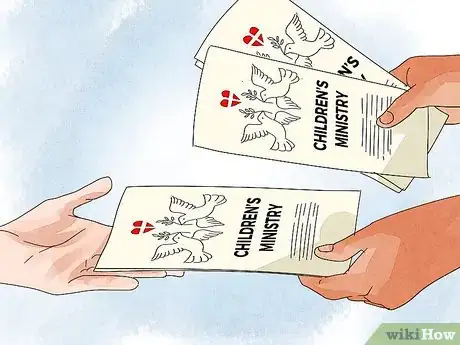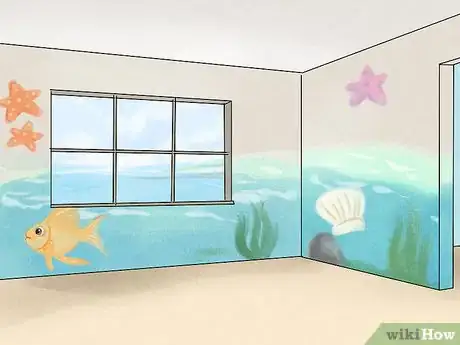X
wikiHow is a “wiki,” similar to Wikipedia, which means that many of our articles are co-written by multiple authors. To create this article, volunteer authors worked to edit and improve it over time.
This article has been viewed 30,079 times.
Learn more...
If you're keen to start a children's ministry or restart an old children's ministry, you'll need to have a mission statement that encompasses your ministry and some members to help you to carry out the project. This article suggests some ways to go about creating a children's ministry.
Steps
-
1The church board should interview several candidates for a children's ministry leader. They will help the board make decisions about the rest of the committee members (coordinators with different responsibilities and lead these members.
-
2Together, the church board and children's ministry leader should create a mission. Your mission statement is a written piece of paper setting out what your children's ministry is out to do. It provides evidence of what your children's ministry promises to do and what it will not do. Remember to hand out your mission. Keep the original and copy it to give out to all of the people in your church before the children's ministry takes off.
- Here is a sample of a mission: We, the children's ministry committee, have set out to do Christ's will by planting the seed of faith and creating an environment where it may continue to grow. We will do our best to serve the Lord as He has called us to, knowing that He creates faith and has created everything. We will do our best to accommodate your needs. We cannot promise that everything will turn out as you please, but we must make all of our decisions for the benefit of the whole congregation. Every child is disciplined and guided in their faith, and parents are educated to raise their children in Christ (as they are the ones responsible for this, not the church). We are set out to keep everyone safe and healthy, as this as our priority. Join us as we carry out Christ's will for us.
Advertisement -
3Based on this mission, create a theme, logo, and slogan for your ministry. Include the logo and slogan on all advertising materials, forms, and handouts. This step may be done before or after you create a children's ministry committee. This group of people should also:
- Decide on the ages of children who will be accommodated with this program. Many cap it at elementary-age kids (through fifth grade). While this may make sense for many churches, many sixth graders are too young for youth group, and it may be best to wait another year before transitioning them; as they are going through enough change regarding middle school already. There is also a possibility of creating a "Junior Youth Group" for kids in fifth through eighth grade, with both mixed-age and age-graded activities (typically separate by grade, as kids may be more familiar with and relate better than with someone who is their same age but a year behind them).
-
4Gather a committee. Look for possible people in the congregation to recruit. The ideal minimum number for people in the committee is seven, however, it may be possible to condense or expand the positions based on church size. Positions may need to be doubled or even tripled. With the help of various volunteers, the church board, and an assistant children's ministry leader, one person may be able to take on coordinating all programs. A committee may consist of: One person for the nursery and new parents of these children, one person for Sunday programs, one special events coordinator (this includes Vacation Bible School, if you choose to hold one), one special needs adviser and coordinator (on tips for creating your ministry special needs-friendly, this person should preferably be an experienced professional), one person to be in charge of training all volunteers in your children's ministry and educating and providing for parents (this could be made into two positions) and one person who is the leader of it all, along with the vice children's ministry leader. Having a vice leader is a good idea so one person can take over if something happens to the leader, and take over to give the leader a break each year. Otherwise, they can be a much-needed assistant to the children's ministry leader. The committee is then formed by the minimum six people in charge of children's ministries. Remember that more or fewer coordinators may be needed depending on the size of the church. There may need to be two or three of each of the positions.
- The church board, along with the children's ministry leader, should interview possible candidates for the committee. These may or may not be paid positions.
- Once your committee is assembled, schedule your first meeting. Talk about fundraising ideas, what else will go into your main programs (besides what the church board has already decided), building or facility renovation plans, supplies needed, and advertising ideas. Remember to try to make your ministry special needs-friendly, but create a room for children to retreat to if they've had enough, and be prepared to have special programming if necessary. The special needs adviser should be responsible for this.
-
5Create a vision. Do this with the committee's help. A vision is a typed paper with all of your goals. Based on these goals, you can choose activities, events, and other tools that will help you get closer to your goal. Remember that God is in control, and you can only do what He has called you to. Create this vision with Him in mind, writing what you feel He wants your ministry to be.
- Here is a sample: Imagine, a children’s ministry facility that sends kids running to the church. It is unique, child-friendly, and immaculate. All surfaces and toys are regularly cleaned, and an updated security system gives parents complete peace of mind when dropping off their kids. There is a nursery full of infants, toddlers and fully certified volunteers. The children are being taught and know that Jesus loves them and cares about them. Laughter and small voices fill the air, as well as a worker’s calm and comforting voice. An updated bulletin board is in full view, all children have name tags and a parent is given a pager in case they’re needed before class is over. The older kids’ rooms are filled to the brim with children. Volunteers are pouring into the ministry, excited to serve in the ways God has called them to. Jaw-dropping experiments are performed, active games get everyone moving and learning the point, Bible stories are experienced and applied in unique ways, arts help visual learners connect to the point, and kids are allowed to get messy and be loud! They know, however, when to quiet down; and they pray whole-heartedly. Worship is both loud and quiet, but kids are praising God with all their hearts! Everything points back to Jesus. Kids are remembering the weekly point and applying it to their lives, and coming back every single week! Parents are being successfully reached with tools and information on how to raise their children in Christ.There is a successful Vacation Bible School program in the summer. Children gather with joy and adults are right with them! Family fall events are held, as well as Easter and Christmas celebrations early on in the season to remind all of the reason for the holidays. And Christian summer programs bring it all together.
-
6Raise funds and advertise. Read "How to Fundraise" for instructions and ideas. Remember not to pressure people into giving. Nobody appreciates this, and the person may need the money for something else. In the Bible, 2 Corinthians 9:7 says, "Each of you should give what you have decided in your heart to give, not reluctantly or under compulsion, for God loves a cheerful giver." It is sinful (wrong) to cause another to sin, including by pressuring them into giving so that they give without a joyful heart! Advertise everywhere. Make sure that your whole town/city knows about your ministry! Include fundraising information, such as where to donate and who to contact for more information). Here are some ideas for ways to get the word spread around:
- Create a bulletin board in your church's main hallway. Use children's hand prints or a border that has to do with your theme or logo. Staple your theme and logo to the top of the bulletin board, and write papers about children's ministry, events, and items that need donated. You can also try putting a paper rocket ship with the number of days left on a chalkboard.
- Hand out brochures. In your brochures, write about what programs your ministry will offer, your children's ministries mission and vision, and pictures. Hand these out all over town and at your church.
- Make a website. If your church already has a website, consider putting the link to your Children's ministry's website. On your website, write a full description of each part of your children's ministry, including: the church nursery, your mission, your vision, Sunday programs, Vacation Bible School, training events and certifications volunteers must do, special events, and any other parts of your children's ministry. Create a page for each different part of your ministry.
- Be colorful! Make sure all pictures and videos are in color, and add colors to your words such as red words for one page, rainbow with all colors on another page, and so on. Color is pretty and appealing to the eye.
- Include pictures! Take pictures of each room in your facility, once it is complete (you may use realistic architectural drawings before it is complete). You don't need to take pictures of the storage room or the training room, just the main places children and adults will be welcome in. Make sure that the rooms look colorful, neat, and appealing in each picture. It's best to keep the rooms like this always, not just for pictures time. As time goes on, take pictures of children doing activities and playing games. Just be sure to ask parents if their children's pictures may go on the children's ministry's website.
- Upload videos. Record training outlines, for volunteers to review and parents to see what volunteers are being taught. Putting slideshows of programs such as a special event or VBS, is a great thing to place on your website.
- Always include your logo and slogan, and contact information. The home page should include this, and having each page include this is even better.
- Try adding clip art. Attach pictures of symbols of "nursery" or "VBS".
-
7Come up with a theme for each of the facility's rooms, or use your ministry's main theme throughout your facility, such as, "Kid's Street: Walking Down the Street of Life with God". Here are some ideas for both individual rooms and entire facilities
- Create a "Kid's Street". Use black and yellow paint to create a "road" on the ground, and use chalkboard paint on the side to create a "sidewalk" kids can draw on with sidewalk chalk. If money allows, create play "buildings" that kids can play in or participate in different activities in. For example, toddlers, preschoolers and kids in kindergarten and first grade would enjoy buildings themed like a grocery store, veterinarian's office, doctor's office, church, school, daycare, home, restaurant, or other places around town. Include age-appropriate themed props and toys within these play buildings. Kids would enjoy having green carpet, and pretend leaves or snow to rake or shovel, and a pretend lawnmower to "mow" the grass. Pretend and real flowers would be fun. Buildings could also be used as "stations" during class. Groups of appropriately mixed-age kids could travel to the art building, then the Bible Times building, the science building, quiet time building (for discussing the day's point and how to apply it to your life, prayer, personal time with God, and various quiet activities), worship building, Real Life Building (for practice applying the Bible to real-life situations), active building, Messy Building (grow with God through messy fun!), a sensory building (complete with sensory-room technology especially for kids with sensory-processing disorder, or for those who just want a break. This room should have a mandatory whisper-to-yourself or otherwise be silent policy to accommodate the needs of others.), and Social Building (for letting kids have a relaxed time to grow with others). Letting kids choose what building they'd like to go to after the Bible Times, Real Life, quiet time, and worship building will help tailor the message to a child's strengths and interests (just make sure that kids aren't allowed to stay at the Social Building for too long, but that they have time to learn about God as well!). Clouds painted on the ceiling will create a nice touch.
- Create a barnyard room for young ones! Paint farm animals on the walls and attach textures such as cotton on the sheep, fake grass on the bottom of the wall, a hairy horse, feathers on a rooster, etc. Also turn a corner of your classroom into the "Barnyard Corner." Provide farm books, farm animal stuffed animals and plastic figures, a sensory table with mud and plastic pigs, a little kiddie pool with paper fish and real nets to "catch" the fish. Another option is to have a tub of soapy water and old clothes to pretend to wash and barnyard dress-up clothes with a full length mirror. You may need to block this area off during class time.
- Create an ocean room. Paint the walls blue and let children paint ocean animals on to the walls. Have a fish tank in your classroom with eels, fish, starfish, and plants. If this is a classroom for younger children, provide a sand table with buckets and shovels, or a water table with plastic ocean creatures. This would also be a great place for a ball pit full of different shades of blue and white balls.
- Another room idea is a tree house room. Paint trees and forest scenes on the walls. Place stuffed forest animals such as squirrels around the room. Having a loft in the room that is named "The Tree house" with a ladder to make it child-accessible will send the excitement through the roof.
- Keep your ministry on the cutting edge! Using donations, try to create play spaces. Indoor and outdoor playgrounds, swimming pools (this idea would take plenty of money, precautions, work, and parental and children's permission, so maybe don't make this your first play space attraction; but keep it in mind for the future), climbing walls, ball pits, bouncy castles, foam play spaces, paintings popping out of the walls, interactive lighting and more create excitement in kids and make them want to come back. Consider hiring a professional children's venue creator/decorator. Spend what you can, and use low-cost ideas for decorating found above and below otherwise. Your ministry's main attraction should be available to everyone of all ages (this will peak interest in your ministry and let guests "check it out", allow families to spend quality time together, and let older children and adults have fun and "be kids again". If however, a church would like to create a separate or blocked-off area for young children and the adults responsible for them, that is fine. This creates an age-appropriate area designed especially for young ones, where they can get away from the "craziness" and not feel overwhelmed by older kids.:
-
8Add decorations for a nice touch.
- Curling ribbon works great to hang from ceilings. Try hanging pastel colors in the church nursery and young children's rooms to create a feeling of comfort. Add primary colors to the ceiling of other rooms to create an energetic feeling. Seasonal or holiday colors are also fun. For example, green and red for Christmas, blue for winter, red for Valentines Day, and so on.
- Mobiles are also nice. You can make a homemade mobile by forming pipe cleaners into a circle and hanging doves, shapes, or other pictures and items form it with string or yarn. Otherwise, you can just purchase a mobile with animals and other items.
- Add children's creations to the space. Try using yarn or string to hang their creations from the ceiling, attaching them to windows and doors, walls, and bulletin boards. Kids will love to see their work up for others to see and take pride in making the room "theirs". Better yet, create a section or room that they can paint all by themselves! Oh, the joy and pride they'll feel in creating their own space; and this activity can create an open-house for your children's ministry. Provide parents and other prospective volunteers with information, and advertise, advertise, advertise. All are welcome!
Advertisement
Warnings
- Always make sure that infant, toddler, preschool, and rooms where special-needs children will occupy are childproofed.⧼thumbs_response⧽
- Closely watch all children, and stick to your state's child-ratio laws. Read "How to Keep the Church Nursery Safe" and '"5 Ways to Help Your Kids Feel Safe" for instructions on keeping kids safe. Also refer to your state's childcare and school safety laws.⧼thumbs_response⧽
- Keep kids healthy. Reading How to Keep the Church Nursery Clean" will give you an idea of the steps necessary to do this, as will reading and sticking to your state's childcare and school health laws. Remember to serve healthy food, create lessons and events where kids have plenty of time to be active, do your best to engage kids without screens, and take precautions during flu season and times when certain viruses are rapidly spreading in your area.
- Educate parents on health and safety practices, and safe house and children's products, as well as care and cleaning routines and methods.
- Remind others (and yourself) that God created our bodies and it is our responsibility to care for them so that they may be of great service to Him. As 1 Corinthians 6:19-20 says, "Do you not know that your bodies are temples of the Holy Spirit, who is in you, whom you have received from God? You are not your own; you were bought at a price. Therefore honor God with your bodies."
Advertisement
About This Article
Advertisement

































































